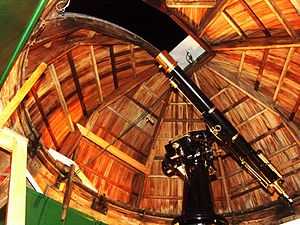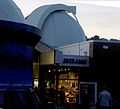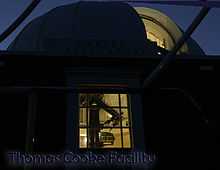Carter Observatory
| Carter Observatory | |||||||
|---|---|---|---|---|---|---|---|
 The Carter Observatory, showing the Thomas Cooke telescope dome | |||||||
| Code | 485 | ||||||
| Location | Wellington, New Zealand | ||||||
Coordinates | |||||||
| Established | 1937 - 1941 | ||||||
|
Website http://www.carterobservatory.org/ | |||||||
| |||||||
The Carter Observatory stands at the top of the Botanic Gardens in Wellington, New Zealand. It re-opened in March 2010 following a NZ$5 million refurbishment, with a new exhibition and digital planetarium celebrating the culture, heritage and science of the Southern Skies.
History
The name commemorates Charles Rooking Carter, who gifted his estate to what later became the Royal Society of New Zealand for the purposes of establishing an astronomical observatory in or near Wellington. Parliament established the Carter Observatory in 1937; it opened in 1941, following some delays caused by the beginnings of World War II.
The observatory became a base for astronomical research in New Zealand. Research began with solar investigations and when new staff joined during the 1970s it expanded to variable stars, galaxies, comets and asteroids. The observatory has had formal research programmes and assists amateur astronomers to perform their own research.
The Carter Observatory became New Zealand's National Observatory in 1977. In recent years, its role "shifted from a focus on research to increasingly concentrate on public education about space".[1]
The Ministry of Research, Science and Technology commissioned astronomer Professor Mike Bessell, Australian National University, to review Carter Observatory’s ability to carry out its functions as New Zealand's National Observatory, to explore New Zealand’s requirements and the opportunities in the National Observatory area, and assess the roles of the various players within the sector. Professor Bessell's report was published in February 2005.[2]
Facilities
The Carter Observatory houses two main telescopes within its main building and a third telescope nearby. The Thomas Cooke telescope, a historic 9¾-inch Cooke Refractor named after Thomas Cooke, serves primarily for public observing sessions. The Ruth Crisp telescope, described below, arrived as a donation in the 1960s. Not far from its main building, the Carter Observatory operates the Thomas King Observatory, used until recently for public viewing of the sun.
The Ruth Crisp Telescope

The Ruth Crisp Telescope, a research-grade 41-cm (16-inch) Cassegrain reflector [3] made by Boller and Chivens of the USA came to the observatory in the 1960s thanks to a donation by the New Zealand writer and philanthropist Ruth Crisp. Once used for research at the Carter Observatory's outstation at Black Birch, in the South Island of New Zealand, it later moved to the main premises in Wellington.
A grant from Pub Charity allowed improvements to the installation in December 2005: the Observatory had the dome motorised and the primary and secondary mirrors re-aluminised. Efforts have commenced to start a research programme based around the facility, possibly involving deep-sky imaging, microlensing capability and photometry.
The Thomas King Observatory

The Carter Observatory also operates the nearby Thomas King Observatory. Astronomers have maintained its 12.5 cm (5-inch) telescope (made in 1882 by Grubb in Dublin) in good condition throughout its nearly 125-year history.
Last refurbished in May 2001, the Thomas King telescope served until recently for public viewing of the sun, with a hydrogen-alpha filter attached. The filter has since transferred to a telescope mounted to the side of the Thomas Cooke refractor in the main observatory building.
Gallery
-

Ruth Crisp Dome and entrance to the Carter Observatory
-

Carter Observatory
-

Ruth Crisp telescope: setting dials
-

Graham Loftus at the Ruth Crisp Telescope
-

Carter Observatory - Thomas Cooke telescope
-

Photo of the sun taken at Carter Observatory (Thomas Cooke telescope)
-

Carter Observatory - Thomas King Observatory
-

Saturn (Thomas King telescope)
See also
- Gifford Observatory, also located in Wellington
- Thomas King (New Zealand)
References
External links
| Wikimedia Commons has media related to Carter Observatory. |